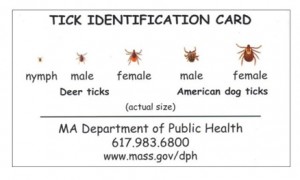by Robert Cooke
A new look into the intricacies of Lyme disease – the dangerous tick-borne infections we pick up in backyards and woodlands here in Boston’s suburbs – shows the corkscrew-shaped bacterium causing Lyme has a surprising metabolic quirk: it needs no iron.
This important discovery, discussed recently in the scientific literature, is important because it may offer a new avenue of attack, an exploitable difference that medical scientists may use in devising effective new treatments.
This also seems to be a landmark discovery, because all other known living organisms depend critically on iron, an element needed for making enzymes, and in other bio-active molecules such as hemoglobin.
Yet instead of iron, the Lyme disease bacterium, “Borellia burgdorferi,” depends on a different metal, manganese, to accomplish its enzyme-building tasks. And this fundamental difference, scientists suggest, may be what allows the Lyme disease bacterium elude the body’s main line of defense against infection, the immune system. And that, perhaps, is one reason chronic Lyme disease is so difficult to treat.
At present, according to Jack Wallace, the Town of Stow’s Health Agent, “there seems to be a lot of ticks this year that survived through the winter,” perhaps because conditions were unusually wet. So he urges families to be extra alert, wearing light-colored clothing and tucking pantlegs into socks. Wallace said children should be checked daily for the very tiny deer ticks, which are hard to detect.
It is abundantly clear that Lyme disease is very common locally– and is spreading nationally. One reason the miniscule deer ticks have become so plentiful is that deer populations have expanded in recent decades. Also, the ticks’ alternate host, the white-footed mouse, is quite common in our suburban and rural environment. So leafy regions such as Stow and Bolton offer fertile territory for both the ticks and the disease-causing bacteria to thrive.
In general, Lyme disease is usually treated successfully with antibiotics — if diagnosed early enough. But untreated and relapsing infections can become really troublesome, eventually leading to serious and chronic health issues such as arthritis, nerve damage and heart problems in some patients.
So, why is iron a biological issue? As far as is known, all other creatures on this Earth require some iron in order to perform the biochemistry involved in making enzymes and other metabolic agents. Many metals, and especially iron, are essential “trace elements” in the normal diet, necessary as key players in normal health. Many specific health problems are directly caused by deficiencies of metals such as zinc, copper and, especially, iron. Having too little iron leads directly to anemia, hampering red blood cells’ ability to carry oxygen throughout the body.
Also, of course, there are metals known to be poisonous, including arsenic, mercury and lead.
The discovery that the Lyme bacterium needs no iron was made 14 years ago by scientists at the University of Georgia. They found that “Borelia burgdorferi,” doesn’t have the genes needed for using iron. So that raised the question: how does it do that? Every other organism known does need iron.
An answer comes from recent work by molecular biologist Valeria Culotta, at Johns Hopkins University’s school of public health. She specializes in studying “metal trafficking” in living organisms, meaning how bacteria and individual cells obtain and use metals in their biological processes.
Culotta and her colleagues collaborated with researchers at the Woods Hole Oceanographic Institution (WHOI), in Falmouth, using an ultra-precise mass spectrometry system developed to perform molecule-by-molecule examination of individual biochemicals. Their achievement was reported in the WHOI publication “Oceanus.”
The collaborating science teams showed that instead of iron, the Lyme disease bacterium uses manganese — a metal next to iron on the Periodic Table of the Elements — to make its enzymes. This difference seems to protect the bacterium from the body’s array of defense mechanisms, perhaps allowing infections to persist. And it’s something worth working on in the search for a cure.
